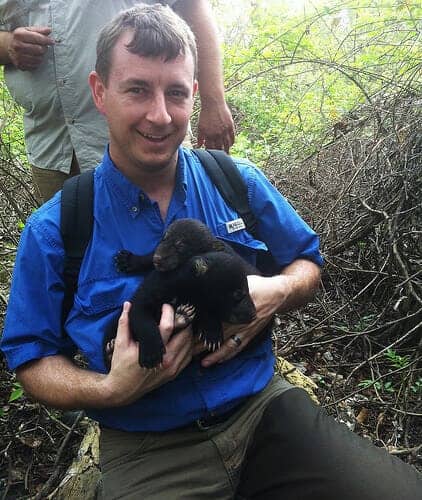On the brink of extinction in 1992, the Louisiana black bear was added to the threatened and endangered species list.
At the time of listing, more than 80 percent of suitable Louisiana black bear habitat was lost. The bottomland hardwood forests of the Louisiana Delta were cleared for row crop production; roads, homes and towns were built; and humans began encountering the shy, but curious, Louisiana black bear more often. The habitat fragmentation, or isolation of suitable patches of hardwood bottoms, affected the bears’ ability to travel for food, to find mates or simply to relocate to a more desirable spot to live.
The U.S. Fish and Wildlife Service’s Louisiana Black Bear Recovery Plan recognized the critical role USDA conservation programs would play in restoring, reconnecting and protecting the habitat, calling USDA’s Natural Resources Conservation Service (NRCS), a “major contributor to habitat restoration and protection via its wetland reserve program.”
“What we’re really talking about here is the power of partnerships. The power of a shared vision for conservation,” said U.S. Fish and Wildlife Service Deputy Director Steve Guertin as he thanked the partners involved with the recovery efforts. “The national wildlife refuge system has been an anchor to the larger effort, but we focused on increasing the ability of these animals to move across the landscape. USDA’s NRCS did the lion’s share of habitat restoration and protection on private lands.”
Affectionately named the “Teddy Bear” after President Theodore Roosevelt refused to shoot one on a south Mississippi hunting trip, the Louisiana black bear is one of 16 subspecies of American black bears.
When the bear was listed there were only three black bear breeding populations left in Louisiana, isolated from each other with as few as 200 bears left. With the vast majority of land in the critical Louisiana black bear habitat privately owned, the fate of the “Teddy Bear” would lie in the hands of private individuals committed to voluntary protection and restoration of the historic bottomland hardwood ecosystem.
In the 23 years since the listing of the Louisiana black bear, NRCS has worked with private landowners who have voluntarily enrolled and restored over 215,000 acres in wetland easements in the prime habitat areas for the bears. Add to that more than 232,000 acres in the Conservation Reserve Program, as well as additional habitat management activities by these landowners in the 14 parishes or counties, and nearly half a million acres of habitat have been restored.
In May, the results of efforts made by numerous conservation groups to restore and reconnect this habitat, including USDA’s Natural Resource Conservation Service, were announced at the Louisiana Governor’s mansion.
The primary habitat corridors have been reconnected, and there are as many as 1,000 Louisiana black bears roaming the hardwood bottoms of the state with four breeding populations and a 99 percent chance of maintaining those numbers. And now, the process has begun to remove the Louisiana black bear from the threatened and endangered species list.
“The recovery of the Louisiana black bear is an exciting and encouraging announcement for our state and for our country,” said Governor Bobby Jindal. “We are not going to stop working on our conservation efforts. We are confident the black bear is here to stay and will remain a celebrated part of Louisiana for many years to come. We wouldn’t be here without tremendous partnerships among the state and federal agencies and the private landowners. I am grateful for their hard work.”

